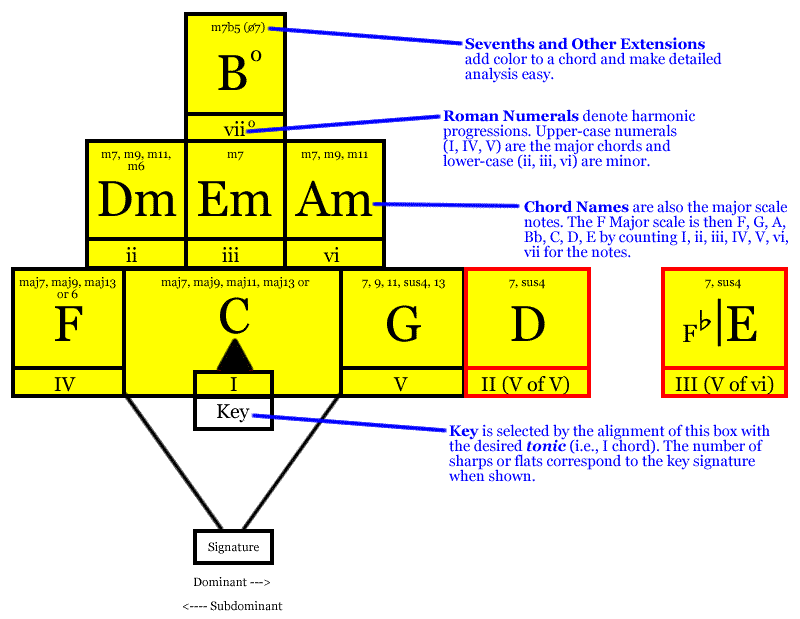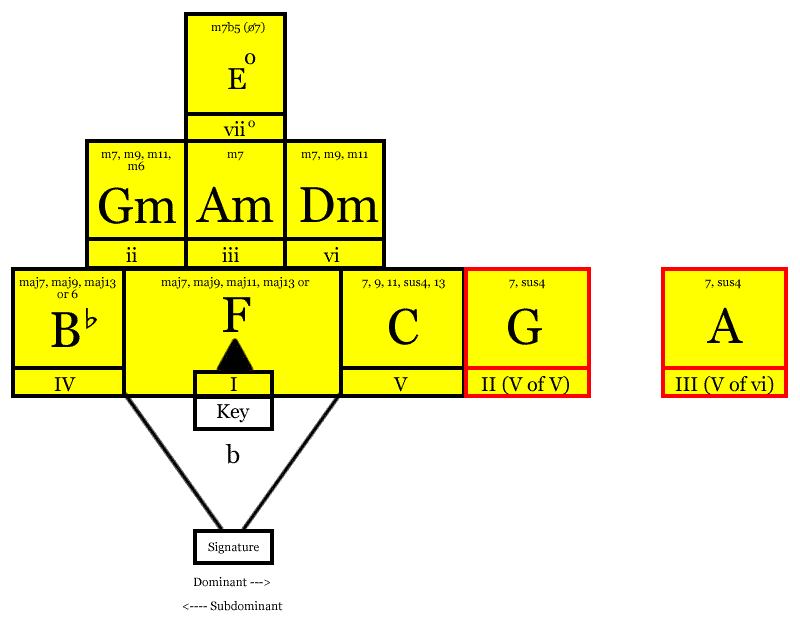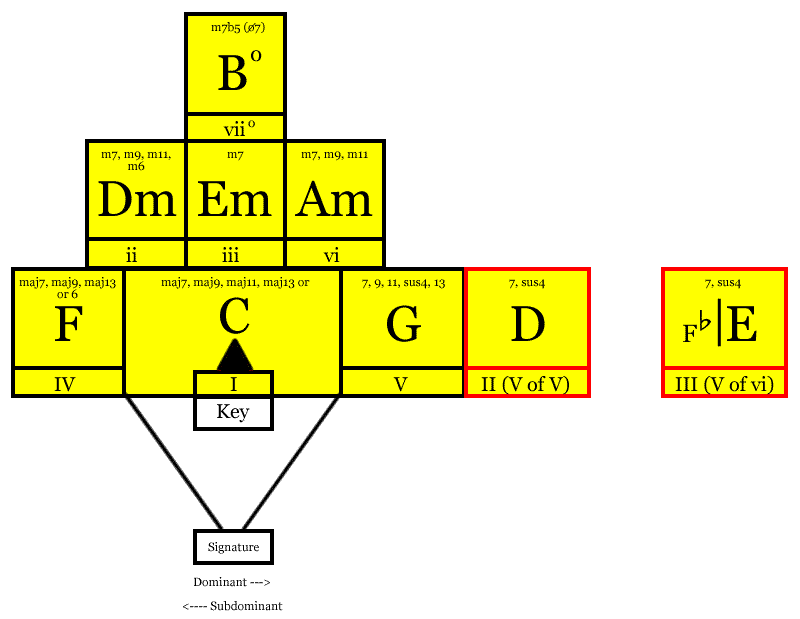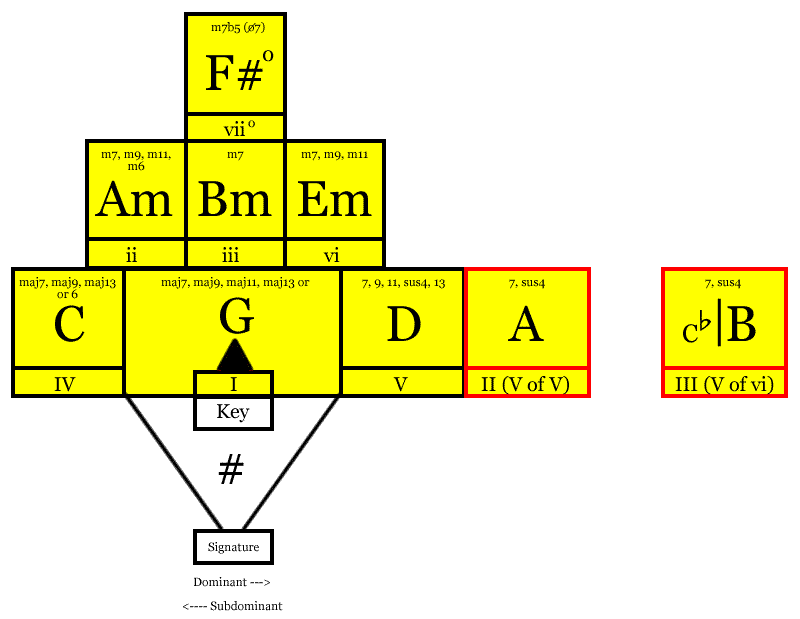I’d like to introduce you to your new best friend. You may have seen it before, but this time – we’ve changed it up a little to make it MUCH more user-friendly and easier to read.
Here it is….
The Chord Bracket
You may be saying, ‘well wait a minute. I’ve seen something like this before. You’re right. It’s actually segments of the famous chord wheel. But as I mentioned before, we’ve made it easier to read.
What It Is…
The chord wheel allows practical application of chord theory. You can determine which chords belong to a given key and analyze any progression instantly.
Here’s a breakdown of what each ‘bracket’ means:

How To Analyze Progressions
With any composition there is an underlying chord progression. The song’s melody as well as any improvisation that is played will be tied to the progression, so this is a must know in order to analyze a progression.
We’ve separated every bracket to make it easier. However, you’ll need to know how to determine the key of a song.
The Analysis
Step 1: Determine The Key – Most chords as individuals can belong to several keys, but when combined into a progression, chords tend to work together to imply a single tonic or key center. This can tell you what scale(s) to use for improvising over the entire progression, which simplifies your job as a soloist – or accompanying strummer as well.
- Just Listen! Listen for a note or chord that sounds most ‘at rest’ – this is usually the first chord or last chord in a song or progression. This would be considered the “I” chord of the key. Warning: This task can be next to impossible with complex progressions that modulate through any number of keys – but for the most part, it usually works.
Step 2: Assign Roman Numberals – Once the key is determined (usually first or last chord of a song) each chord can be assigned a Roman Numeral (I, ii, V, etc.) based on the position and function within the key.
- By analyzing your favorite style of music, you will learn how the given piece symbolizes the tension and release in the song’s composition. Frequent modulations and use of “ii-V-I” are common in Jazz progressions, while rock/blues tend to rely more on progressions such as “I-IV-V”.
- Accompaniment and Improvisation between multiple guitarists is usually a theoretical concept. If a songwriting partner tells you that he or she would like you to work on a song that ‘cycles forward along the circle of fifths using a “vi-ii-V7-I” theme, but the bridge modulates to somewhere harmonically distant so that it has an ‘outside’ sound, you’ll be able to follow along easily!
Example Progression – The Verse
| Verse | Fmaj7 | Dm | Gm7 | C7 |
|---|---|---|---|---|
| Fmaj7 | Dm9 | Am | Bb |
Here is a typical verse progression. (Left to right, as in: Fmaj7, Dm, Gm7, C7 | Fmaj7, Dm9, Am, Bb)
Tomorrow we will be working with a sample chorus, so be sure you understand what is happening here. The first thing we do of course is (1) Determine the Key.
We do this by looking at the chords provided, trying to find as many of the above chords within the triangle outline. Since we have broken the wheel into brackets, we’ve taken out all the work for you. Later on in this tutorial you will get the full wheel so that you can print it out. For now, let’s just show you how it works.
Only one position contains all of the chords in the verse: the key of F.

(Logically this would also be true because the Fmaj7 is the first chord of the progression.) Since all of the verse’s chords fit in the brackets without any exception, all of the chords are completely in key – or diatonic.
Now, you can (2) assign Roman Numerals – in other words – assign the root progression. These are shown at the bottom of each cell within the brackets. Let’s see if you got the same answer we did:
| Verse | Fmaj7 | Dm | Gm7 | C7 |
|---|---|---|---|---|
| Fmaj7 | Dm9 | Am | Bb |
Becomes….
| Key of F: | Imaj7 | vi | ii7 | V7 |
|---|---|---|---|---|
| Imaj7 | vi9 | iii | IV |
Example Progression – Part II: The Chorus
| Chorus | Dm | G7 | C | Cmaj7 |
|---|---|---|---|---|
| Am | D7 | G | A7 – Gmaj7 |
Now let’s move on the chorus. Above you’ll see after a little trial and error that we are no longer in the key of F.
By looking at the chords above you’ll notice that there is no single key that contains all of the chords. That tells us that the chorus either modulates to one or more other keys OR contains at least one accidental (a chord outside the key).
The strongest analysis indicates modulation. The first half of the chorus is in the key of C, and then we modulate to the key of G for the second half.
Key of C:

Key of G:

Harmonic (Root) Progressions For The Chorus
| Key of C: | ii | V7 | I | Imaj7 |
|---|---|---|---|---|
| Key of G: | ii | V7 | I | II7 Imaj7 |
Once you begin to understand a progression, you have at your disposal a roadmap for creating the perfect soloing as well as accompaniment. For instance, with the above progression, you can start by playing lines based on an F major scale during the verse and then employ licks based on the C major scale for the first four measures of the chorus (next four measures use G major scale).
Naturally you would want to add variations and pay attention to the chord tones (emphasize tones found within each chord).
Tips For Analyzing
Modulations/Accidentals – While many popular songs remain entirely in one key, songs do tend to modulate, or move to different keys. If in the middle of a verse there comes a chord that comes out of nowhere, it’s probably out of key, or an accidental. (This does not mean it was an accident – it just means it was unpredictable).
Common Chords – Did you see that the chord Dm was also used in the verse? This is quite typical because a chord can belong to several keys. This is also the reason why sometimes a chorus and verse work so well together. Common chords like this are called pivot chords because they are used as transitions between keys.
Unique Chords – When you analyze a progression, watch for chords that are unique to a given key. In the instance of a dominant seventh chord, such as G7, D7, or A7, remember that it can only be diatonic to a single key, where it functions as a V7.
Substitutions – IMPORTANT! There is one exception to the rule on dominant seventh chords. A substitution is a chord that replaces another chord in a given progression to add variety. A common substitution is the b5 or tritone substitution. Basically it is a chord that is on the exact opposite side of the Chord Wheel. Most common it is applied to the V7. In other words, in the key of G, the substitution for the V7 (D7) would be the Ab7 – exact opposite of the D7. EUREKA!